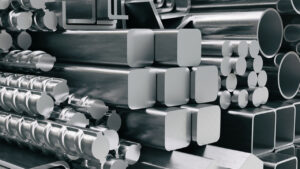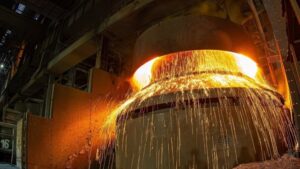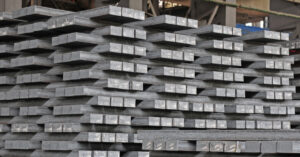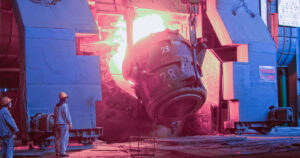
In October of this year, Ukrainian metallurgical companies increased steel production by 7.3% compared to the same period last year, from 604,000 tons to 648,000 tons, but decreased by 5.9% compared to the previous month (611,000 tons).
In the ranking of global producers of this product, compiled by the World Steel Association (Worldsteel), Ukraine ranked 21st among 70 countries.
According to Worldsteel, in October 2025, there was a decrease in steel production compared to October 2024 in most of the top ten countries, except for India, the US, Turkey, and Iran.
The top ten steel-producing countries in October were as follows: China – 72 million tons (down 12.1% compared to October 2024), India – 13.563 million tons (up 5.9%), the US – 6.989 million tons (+9.4%), Japan – 6.853 million tons (-1%), Russia – 5.250 million tons (-6.2%), South Korea – 5.093 million tons (-5.8%), Iran – 3.316 million tons (+12%), Turkey – 3.208 million tons (+3.1%), Germany – 3.127 million tons (-3%), and Brazil – 2.988 million tons (-2.7%).
Overall, steel production in October this year decreased by 5.9% compared to the same period last year, to 143.340 million tons.
Based on the results of the first ten months of this year, the top ten steel-producing countries are as follows: China – 817.870 million tons (-3.9% compared to January-October 2024), India – 135.987 million tons (+10%), the United States – 68.376 million tons (+2.8%), Japan – 67.327 million tons (-4.1%), Russia – 56.536 million tons (-4.9%), South Korea – 51.144 million tons (-3.6%), Turkey – 31.277 million tons (+1.2%), Germany – 28.505 million tons (-9.9%), Brazil – 27.988 million tons (-1.8%), and Iran – 25.442 million tons (-1%).
Over the first ten months of this year, Ukrainian steel companies reduced steel production by 4.9% compared to the same period last year, from 6.487 million tons to 6.172 million tons. The country ranked 22nd.
In general, global steel production in January-October 2025 decreased by 2.1% compared to the same period in 2024, to 1 billion 517.589 million tons.
As reported, at the end of 2024, the top ten steel-producing countries among 71 countries were as follows: China – 1 billion 5.090 million tons (-1.7%), India – 149.587 million tons (+6.3%), Japan – 84.009 million tons (-3.4%), the United States – 79.452 million tons (-2.4%), Russia – 70.690 million tons (-7%), South Korea – 63.531 million tons (-4.7%), Germany – 37.234 million tons (+5.2%), Turkey – 36.893 million tons (+9.4%), Brazil – 33.741 million tons (+5.3%), and Iran – 30.952 million tons (+0.8%).
In total, 71 countries produced 1 billion 839.449 million tons of steel last year, which is 0.9% less than in 2023.
At the same time, Ukraine produced 7.575 million tons of steel in 2024, which is 21.6% higher than in 2023 (6.228 million tons). The country ranked 20th in 2024.
In 2023, China produced 1 billion 19.080 million tons (at the level of the previous year), India – 140.171 million tons (+11.8%), Japan – 86.996 million tons (-2.5%), the US – 80.664 million tons (+0.2%), Russia – 75.8 million tons (+5.6%), South Korea – 66.676 million tons (+1.3%), Germany – 35.438 million tons (-3.9%), Turkey – 33.714 million tons (-4%), Brazil – 31.869 million tons (-6.5%), and Iran – 31.139 million tons (+1.8%). In total, 71 countries produced 1 billion 849.734 million tons of steel in 2023, which is 0.1% less than in 2022.
At the same time, Ukraine produced 6.228 million tons of steel in 2023, which is 0.6% less than in 2022. The country ranked 22nd in 2023.
At the end of 2022, the top ten steel-producing countries were as follows: China – 1.013 billion tons (-2.1%), India – 124.720 million tons (+5.5%), Japan – 89.235 million tons (-7.4%), the United States – 80.715 million tons (-5.9%), Russia – 71.5 million tons (-7.2%), South Korea – 65.865 million tons (-6.5%), Germany – 36.849 million tons (-8.4%), Turkey – 35.134 million tons (-12.9%), Brazil – 33.972 million tons (-5.8%), and Iran – 30.593 million tons (+8%).
Ukraine ranked 23rd in 2022 with 6.263 million tons of steel (-70.7%).
In total, 64 countries produced 1 billion 831.467 million tons of steel in 2022, which is 4.3% less than in 2021.

Metinvest, Ukraine’s largest mining and metallurgical holding company, reduced steel production by 10% year-on-year to 1.455 million tons in January-September this year.
According to a press release from the parent company Metinvest B.V. on the results of its operating activities for Q3 2025, the decline in production was due to the full-scale military invasion of Ukraine.
As a result, the capacity utilization rate of the group’s plants in Ukraine was affected by factors related to security, personnel, electricity, logistics, and the economy. In 2025, Russia intensified its large-scale attacks on
Ukraine’s energy and gas infrastructure. In October, after the reporting period, this led to damage to the power supply systems at two of the group’s facilities in the mining and metallurgical segments, resulting in a decline in production.
In the third quarter of 2025, pig iron and crude steel production at Kamet Steel increased by 41% and 30% compared to the previous quarter, respectively, to 497 thousand tons and 546 thousand tons. The growth was due to the overhaul of blast furnace No. 9 in April-June 2025 and its higher productivity in the reporting period.
In the first nine months of 2025, pig iron production decreased by 6% compared to the same period last year to 1.285 million tons, mainly due to the overhaul of blast furnace No. 9 at Kamet Steel. As a result, crude steel production decreased by 10% compared to the same period last year to 1.455 million tons.
Pig iron and steel production in the third quarter of 2025 doubled compared to the previous quarter to 267 thousand tons, due to an increase in hot metal production. In the first nine months of 2025, production of semi-finished products fell by 9% year-on-year to 568,000 tons due to a decline in steel production and an increase in domestic consumption of billets at subsequent stages of production.
In the third quarter of 2025, finished product production decreased by 6% year-on-year to 591 thousand tons due to scheduled maintenance of rolling mills in Italy and Bulgaria in August. In particular, flat product production decreased by 8% to 265 thousand tons, and long product production decreased by 4% to 326 thousand tons.
In the first nine months of 2025, finished product production increased by 8% year-on-year to 1.818 million tons. In particular, flat steel production increased by 12% to 817,000 tons due to the resumption of hot-rolled coil production at the Ferriera Valsider plant (Italy), while long steel production increased by 5% to 1.001 million tons.
In the third quarter of 2025, coke production increased by 4% compared to the previous quarter to 287,000 tons after the launch of additional chambers of coke oven battery No. 2 at the Zaporizhzhya Coke Chemical Plant in June 2025. In the first nine months of 2025, coke production decreased by 3% to 821,000 tons due to the shutdown of coke oven battery No. 1 at Kametstal.
At the same time, in the third quarter of 2025, total iron ore concentrate production amounted to 3.989 million tons, which remained almost unchanged compared to the previous quarter, while commercial iron ore production increased by 4% to 3.928 million tons. Iron ore pellet production increased by 7% to 1. million tons due to the overhaul of the roasting machine at the Central Iron Ore Plant in the previous quarter, while iron ore concentrate production remained almost unchanged at 2.226 million tons.
In the first nine months of 2025, total iron ore concentrate production decreased by 4% compared to the same period last year to 11.713 million tons, as operations at the Ingulets open pit were suspended in July 2024. This was partially offset by increased production at the Hannivskyi open pit. Commercial iron ore production remained almost unchanged year-on-year at 11.456 million tonnes, including a 6% decline in iron ore concentrate production and a 9% increase in pellet production.
In December 2024, operations at the Pokrovskoye Coal production site were suspended due to intensified hostilities and developments on the front line. Subsequently, due to power shortages and a further deterioration in the security situation, both the mine and the enrichment plant suspended operations.
In addition, the group is considering the sale of United Coal (US) and its exclusion from its financial statements for the first half of 2025. This is due to the negative impact of geological difficulties, depletion of coal reserves, higher logistics costs, and a steady decline in coking coal prices.
As reported, Metinvest increased steel production by 4% in 2024 compared to 2024, to 2.099 million tons, while total iron ore production increased by 42%, to 15.733 million tons. At the same time, commercial iron ore concentrate production grew by 58% to 14.826 million tons. Coke output in 2024 decreased by 10% to 1.122 million tons. Metinvest increased its total production of pellets by 14% to 6.022 million tons, but reduced its total output of coking coal concentrate by 22% to 4.277 million tons.
Metinvest is a vertically integrated group of mining and metallurgical enterprises. Its enterprises are located in Ukraine, in the Donetsk, Luhansk, Zaporizhzhia, and Dnipropetrovsk regions, as well as in the European Union, the United Kingdom, and the United States.
The main shareholders of the holding are SCM Group (71.24%) and Smart Holding (23.76%). Metinvest Holding LLC is the managing company of the Metinvest Group.

In January-September of this year, Ukraine reduced exports of semi-finished carbon steel products in physical terms by 38.5% compared to the same period last year, to 941,511 thousand tons.
According to statistics released by the State Customs Service (SCS), in monetary terms, exports of carbon steel semi-finished products fell by 40.7% to $450.242 million.
The main exports were mainly to Bulgaria (36.68% of supplies in monetary terms), Turkey (16.78%), and Poland (13.70%).
During the period in question, Ukraine imported 80,635 thousand tons of semi-finished products worth $59.445 million, mainly from Oman (37.26%), Germany (22.19%), and India (16.31%), while in the first nine months of 2024, it imported 5 tons of semi-finished products worth $5 thousand.
As reported, in 2024, Ukraine increased its exports of semi-finished carbon steel products in physical terms by 56.7% compared to 2023, to 1 million 886,090 tons, while revenue in monetary terms increased by 52.4% to $927.554 million. The main exports were to Bulgaria (32.06% of supplies in monetary terms), Egypt (18.50%), and Turkey (11.14%).
In 2024, Ukraine imported 306 tons of semi-finished products worth $278 thousand from the Czech Republic (88.13%), Romania (7.19%), and Poland (2.88%), while in 2023, it imported 96 tons worth $172 thousand.

China has unveiled a new action plan for the steel industry, which includes a set of measures to address the chronic problem of oversupply. This comes amid Beijing’s intensified efforts to end a series of price wars raging in the economy, writes the South China Morning Post.
The plan, which includes a strict ban on the commissioning of additional capacity and measures to accelerate the decommissioning of obsolete equipment, could serve as an example for other industries suffering from overproduction and excessive competition.
The document, published on Monday by the Ministry of Industry and Information Technology in conjunction with a number of other agencies, calls for strict control over steel production capacity and volumes. It stresses that “coordinated efforts on both the supply and demand sides” are needed to stabilize the industry.
The plan aims to “accelerate the transition from old to new growth drivers, develop new productive forces, and further enhance the resilience and security of industrial and supply chains.” The steel industry should strive to increase added value by approximately 4% annually over the next two years and complete the modernization of more than 80% of steel production capacity to achieve ultra-low emissions by the end of this year.
Although Chinese steel companies account for more than half of global production, the average profitability of listed companies in 2024 was minus 0.26% due to structural problems in the industry, the report said.
According to CINDA Securities, 7.44 million tons of five major types of steel products were produced in the country in the first half of September, approximately 5.8% more than in the same period a year earlier. Steel inventories increased by 12.1% to 11.01 million tons, while consumption fell by approximately 4.6% to 8.5 million tons.
The composite steel price index is currently at 3,507 yuan ($493) per ton, which is approximately 2.6% higher than last year’s figure, but approximately 14% lower than in 2023.
In 2024, China reduced steel production by 1.7% to 1.005 billion tons.